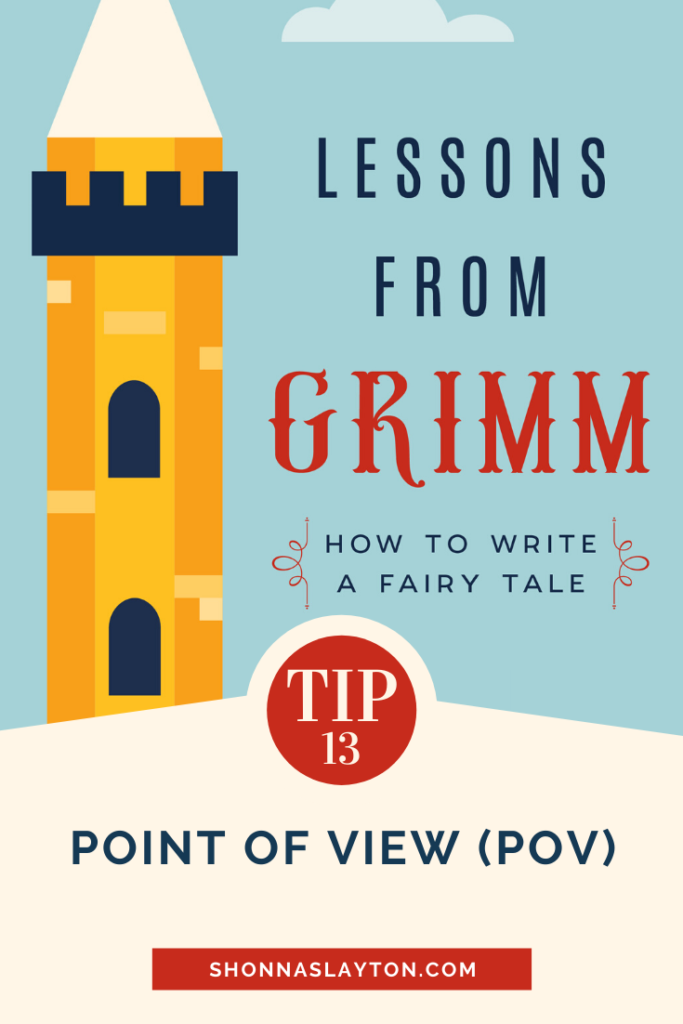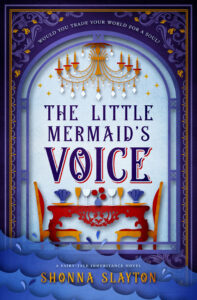Grimm’s fairy tales are told in omniscient POV where the “camera” is viewing everything from the outside. The result is an impersonal, objective way of storytelling. We don’t know the internal dialogue or feelings of the characters other than what we imagine them to be.

Modern retellings get more personal. They are generally told in either first person (I entered the grand hall after the suitors had arrived. These are my choices?) or third person deep / close / tight (The princess entered the grand hall after the suitors had arrived. These are my choices?)
Note: third person deep POV makes third POV seem almost like first person. The writer strips out extra words like: thought, saw, felt…
- “These are my choices?” she thought. (3rd POV)
- These are my choices? (3rd person deep POV; thoughts are italicized)
- She saw the suitors standing in a line against the wall. (3rd POV)
- The suitors stood in a line against the wall. (3rd deep POV)
Notice, that these 3rd deep POV examples, pulled out of context could also be 1st person POV should the surrounding text use the pronoun “I.”
Writers also have the choice of present or past tense:
- I enter the grand hall…(1st person present.)
- I entered the grand hall…(1st person past.)
- The princess enters the grand hall…(3rd person present.)
- The princess entered the grand hall…(3rd person past.)
How do you chose which POV format to use? Personal preference and your natural writing bent certainly help you decide. If you naturally write one way over the other, stick with that so you don’t have to edit as many mistakes. You’ll want to keep your POV consistent.
The biggest consideration when choosing POV is which character you want the reader to experience the story through.
Writers usually look for the character who has the most to lose in the story. Who has the highest stakes? This is usually the main character, but sometimes (The Book Thief comes to mind) the author will tell the main character’s story using another character’s POV.)
To summarize, when determining POV, writers look at:
- 1st or 3rd person (there are other choices, but we’re talking current trends)
- Past or present tense
- Which character voice should tell the story.
Some examples from this week’s readings:
The Foundling-Bird
In The Foundling-Bird, the story begins with a woodsman finding a boy who had been plucked from his mother’s arms by a hawk. Instead of returning the boy to his sleeping (dead?) mother he brings him home to raise with his daughter.
The tale then switches to the girl, Lena, and her plans to keep Foundling safe from the family cook who is trying to kill him. Lena makes all the decisions for the two of them until they are able to kill the cook, who is a witch.
To take this from omniscient POV to 1st or 3rd person POV, who in The Foundling-Bird has the most to lose?
Foundling is the one whose life is on the line, but it is Lena who feels responsible for keeping her adopted brother alive. She is the one who makes all the decisions and has the agency to do something about it. She becomes the active character in the story. Presumably, she is the older of the two, which explains why she is protecting him and also decides what to do.
If this story was written from her POV, we’d see everything through her eyes. The story of how Foundling came to their home would have to be told in dialogue from her father when he brought the boy home, either in real time or in a flashback.
We’d be privy to her thoughts about why she is so desperate to save Foundling, and why she didn’t tell her father that night about what the cook was planning to do in the morning.
To tell the story from Foundling’s POV we’d have to work a bit harder, pulling away from the text and making Foundling more active in the escape and saving of his own life.
King Thrushbeard
I’d never read this story before, but immediately thought Taming of the Shrew (Shakespeare) meets Fairy Tale! How fun.
This story is begging for a retelling, and King Thrushbeard told in first person point of view would be a much stronger tale. Especially since there is a twist at the end, if the story was told in the princess’s POV, a skilled writer would be able to hide the twist to make it a more satisfying payoff.
Also, because this story walks a fine line between love and abuse, the POV from the female perspective would be critical to know which side of the line the retelling falls on. Because the story is set up to be a deeply emotional and transformative one, for full impact, 1st POV present tense would make it the most immediate to the reader. But again, that’s a choice for what the author is most comfortable writing.
Little Briar Rose (Sleeping Beauty)
This one is tricky. What do you do when your main character begins the story as a baby and then sleeps for 100 years while a new generation grows up around her legend?
One easy fix is to tell the story using multiple POVs: perhaps start with the mother, switch to the princess, and then to the prince. Or start with the princess and use a flashback to tell her birth history. That way you can stick to two POVs, the prince being the second.
The Disney version of Sleeping Beauty solves this by telling the story from the perspective of the fairies.
Warning! No head-hopping. Try to keep your POV consistent within a scene for maximum impact and less confusion. An easy way to do this is to stick to one POV for each chapter.
For me, most of my books are single POV, but in The Tower Princess, I go back and forth between Manny and Gressa who live on either side of a wall in a divided kingdom. In this case, each character gets their own chapter. Even then, I had to weed out mixed POV in edits.
The Six Swans
In the Six Swans, the most active character is the sister. She is the one with agency who saves her brothers. She’s the one who is attacked by her mother-in-law. You’d need to add scenes in the beginning for her to find out information from her father, like the magic ball of yarn. Her internal thoughts will be very important during the time she is not able to speak.
Not sure what your favorite POV is? Short fairy tale retellings are perfect for testing out POV. Because in the end, writers need to feel comfortable writing in whatever POV they’ve chosen, no matter what is trending.




